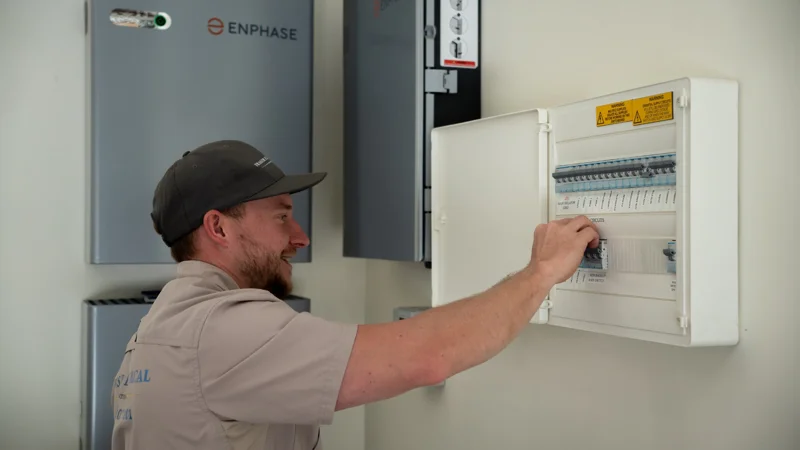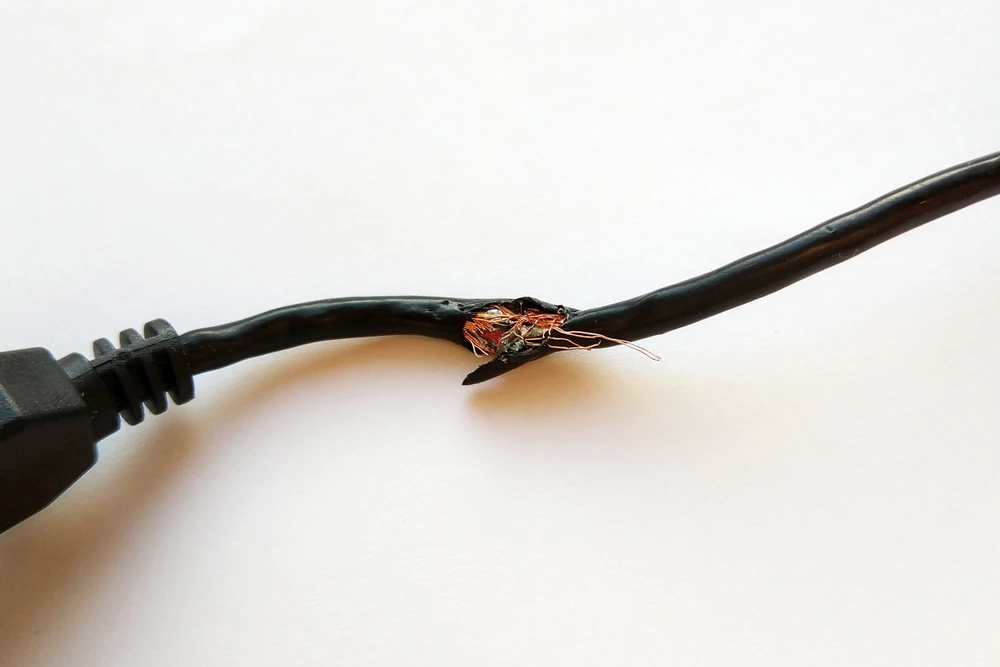When a storm passes, its impact doesn’t end with the wind and rain. Homes are often left vulnerable, with damaged roofs, flooded basements and unpredictable electrical issues lurking behind walls and ceilings. The combination of water, electricity and structural damage can turn a home into a serious hazard zone. At Fraser Electrical, we know how quickly storm damage can escalate when electrical safety isn’t prioritised. That’s why knowing how to respond calmly and correctly can make all the difference in protecting your family and property.
Below, we’ll walk you through the essential steps to take after a storm, debunk common myths about restoring power and show why professional electrical support is critical in emergencies. Let’s get started!

In the storm’s aftermath, your first instinct might be to assess property damage, but electrical safety must always come first. Even if the power looks off, hidden risks may linger in flooded switchboards or damp wiring. Acting quickly and calmly prevents accidents, fires and further system failure.
Before inspecting or entering storm-damaged areas, determine whether it’s good to access your switchboard. If the area is dry and clear of hazards, turning off the main power supply can prevent electrocution or system overloads. However, if water has entered your home or surrounds the switchboard, avoid touching it.
Fallen power lines are among the deadliest risks. They may appear harmless but can remain live and energised. Maintaining distance ensures you avoid indirect contact through wet surfaces or metal objects.
Water and electricity are a dangerous mix. And during or after a storm, even minor exposure can cause shock or equipment failure. Wait until your home’s system is tested before plugging in devices. The following is what you should do:
In some cases, the decision you can make is to leave your home. Electrical systems can become dangerously unstable when exposed to flooding, fallen power lines or structural collapse. Even if damage appears minor, hidden electrical faults can quickly escalate. Don’t wait for visual confirmation of danger; electricity can travel through unseen pathways such as wet flooring, metal objects, or even concrete. Evacuate immediately if:

Once the storm has passed and the winds have settled, the next challenge begins: restoring electricity. For many homeowners, that first flicker of light after an outage feels like a small victory. But behind every switch and socket lies a complex electrical network that may have suffered damage from water, debris or power surges. Acting too quickly, or based on misinformation, can turn a simple outage into a major hazard. This section addresses some of the most common myths surrounding power restoration.
After hours without electricity, flipping the switch yourself can feel tempting. But storms often leave hidden faults behind. One wrong move and you could trigger a fire or electric shock. The truth? Only a certified technician can restore your system after exposure to moisture or debris.
Many assume a quick breaker reset will restore normal function. In reality, breakers often trip for a reason and it is to prevent overload or short-circuiting caused by damage. However, flipping breakers without inspection can aggravate underlying faults. Have a trained electrical specialist inspect your setup.
Generators are valuable tools during outages, but they require careful operation to prevent accidents. But in reality, without proper transfer switches, generators can feed power back into the grid, endangering repair crews and your property. Always operate them outdoors, far from living areas and have a professional install a compliant connection system.
When the skies finally clear, your home’s electrical system can still be unpredictable. What appears stable one moment may fail the next. That’s why calling an emergency electrician in Central Coast isn’t a luxury; it’s a necessity. They can quickly identify hazards, stabilise your power supply and prevent long-term damage that often goes unnoticed.
One of the overlooked dangers following severe weather is the silent threat of electrical fires. Floodwater, debris and damaged insulation can all create invisible faults within your wiring system. What appears harmless at first can escalate into a fire hours or even days later. Having a licensed expert inspect and test your system ensures that every damaged or compromised component is identified and isolated before it can ignite. Prevention is always less costly than repair.
Restoring electricity is not as simple as flipping a switch; it’s a process that requires precision, experience and compliance with strict standards. Every circuit, breaker and outlet must be carefully tested to confirm it’s dry, intact and capable of carrying current safely. By trusting professionals with this step, you protect your home and ensure your entire electrical network is operating within parameters.
Storm damage often leads to one of the most stressful parts of recovery: filing insurance claims. However, few homeowners realise that attempting DIY electrical repairs or reactivating power without a professional assessment can void insurance coverage. As experts, we regularly assist clients who require detailed inspection reports and certification to support their storm-related claims. With a qualified professional, you protect your eligibility for reimbursements and future claims.
Every minute can feel like an hour, especially when you’re sitting in the dark, hearing the distant hum of generators or the crackle of fallen power lines outside. Understanding how response times work can help you stay calm and plan your next steps effectively. A well-prepared electrical company operates on a triage system, handling calls based on severity and immediate risk:
While waiting, homeowners can assist by:

After ensuring your family’s safety, it’s natural to survey the damage. However, not all damage is visible, and not everything should be touched. Water intrusion, hidden wiring faults and weakened components can create serious electrical hazards long after the storm clouds have cleared. By taking a methodical approach, you’ll help ensure that hazards are identified early and your home returns to normal as quickly as possible.
Water and wiring never mix. Even small leaks can compromise outlets and switches. Examine walls for stains, dampness or condensation near electrical fixtures. Also, avoid touching wet outlets. Instead, photograph and report them. Note any water around your switchboard or metre box.
Electrical arcing can leave behind subtle signs that indicate serious internal damage. Scorch marks or melted plastic near sockets suggest overheating. Remember, a persistent burnt smell may point to short circuits. Calmly and properly evacuate if smoke is present.
Outdoor systems are highly exposed during storms, and even minor damage can cause danger when power returns. Check pool pumps, outdoor lights and solar systems for debris or flooding. Do not attempt to clean or reset any external electrical device. And leave all external inspections to professionals once conditions are okay.
Clear, detailed documentation helps professionals understand the full extent of storm impact. Take timestamped photos before cleaning or disposal, and create a list of affected rooms and visible damage. Better keep all receipts and reports for your insurance provider.
Recovering from a storm is only half the story; the other half is learning from it. With power restored and hazards addressed, it’s the perfect time to prepare for future outages. Every storm exposes vulnerabilities in your electrical system, from weak wiring and outdated switchboards to the lack of surge protection or backup power solutions. Addressing these gaps now can make the next outage far less stressful, costly and dangerous.
Power surges from lightning or grid fluctuations can silently destroy appliances. However, a whole-home surge protector shields your system from future spikes. It also extends the life of electronics and reduces costly replacements. It’s better to ask your electrician to include it during your next switchboard upgrade.
Emergency energy solutions provide comfort and functionality during blackouts. You should consider a standby generator if you have a large home or critical systems. You can pair solar panels with battery storage for sustainable, quiet backup. Also, regularly test backup systems to ensure they operate correctly when needed.
Preventive maintenance identifies vulnerabilities before they become crises. Annual inspections detect loose wiring, corrosion or outdated systems. You can request thermal imaging checks to spot overheating circuits early. And regular service ensures your home remains compliant with current electrical standards.
Every household should know what to do when power suddenly fails. Label your main switchboard clearly and keep access unobstructed. Save emergency contacts for your electrical and utility provider. Of course, store instructions, flashlights and backup batteries in an easy-to-reach location.
Storms may be unpredictable, but your electrical safety response doesn’t have to be. Acting swiftly, thinking and contacting licensed professionals can make the difference between a smooth recovery and lasting damage. At Fraser Electrical, we’re committed to helping homeowners navigate emergencies with confidence and care. From post-storm inspections to preventive maintenance, our goal is to restore reliability and peace of mind to every home we serve.